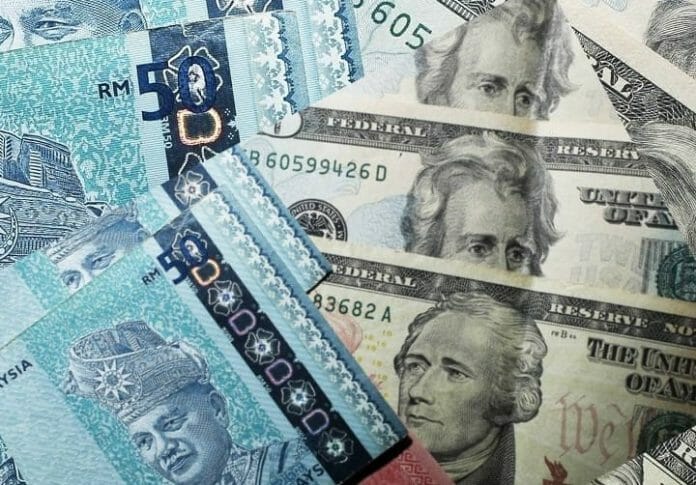The ringgit traded higher against the US dollar at the opening on Thursday (March 2), amid conflicting signals from the United States (US) on inflation and interest rates, said an analyst.
At 9am, the local note rose to 4.4670/4745 against the US dollar, from Wednesday’s close of 4.4710/4740.
The US ISM Manufacturing PMI, another indicator of inflation, rose only a tad higher to 47.7 points in February from 47.4 points in the preceding month but below the 48.0 points from consensus estimates.
Bank Muamalat Malaysia Bhd head of economics and market analysis Mohd Afzanizam Abdul Rashid said one of the voting members for the US Federal Open Market Committee (FOMC), Neil Kashkari, indicated that he was open to a 25 basis points hike (bps) or 50 bps in the upcoming meeting in March.
Similarly, non-voting member Raphel Bostic suggested the Fed funds rate should be in the range of 5.00% to 5.25%, and that such a level needs to be held steady well into 2024.
“The hawkish tone by US Federal Reserve (Fed) officials continues to hog the limelight,” he told Bernama.
As such, Mohd Afzanizam foresees the ringgit to remain rangebound against the greenback ahead of the FOMC meeting in mid-March.
The ringgit traded higher against a basket of major currencies, except against the euro, where it fell to 4.7618/7698 from 4.7580/7612 on Wednesday.
The local unit improved against the Japanese yen to 3.2783/2843 from 3.2916/2941, and rose against the British pound to 5.3693/3783 from 5.3956/3992, previously.
The ringgit also traded higher against some Asean currencies.
It increased versus the Singapore dollar to 3.3256/3315 from 3.3333/3361 on Wednesday, and expanded vis-a-vis Thai baht to 12.8381/8652 from 12.8484/8637.
The ringgit was slightly better against the Philippine peso at 8.12/8.14 from 8.13/8.14, and the Indonesian rupiah at 293.10/293.80 from 293.40/293.80 on Wednesday.
The dollar nursed losses on Thursday as optimism about China’s reopening was supported by encouraging data and underpinned Asian currencies, while sticky inflation had the euro eying its best week in a month and a half.
The dollar lost 0.9% on the euro overnight, and since it moved lower despite US yields rising some are speculating it might have peaked as February’s rally runs out of steam, Reuters reported.
The euro is up 1.2% on the week and last bought US$1.0667 with hotter-than-expected German inflation in February adding to pressure on the European Central Bank to raise rates following unexpectedly strong readings in France and Spain.
“The turn in the dollar came right on schedule as month end flows fizzled and the dominant driver of euro/dollar, rate differentials, reasserted itself,” said Brent Donnelly, president of analytics firm Spectra Markets.
Eurozone inflation data is due later in the day.
The yen hardly budged but the dollar made broad falls on Asian currencies as it retreats from recent highs.
China’s better-than-expected manufacturing activity set the yuan on its biggest one-day jump of the year so far on Wednesday, surging about 0.9%.
On Thursday the yen was a tad stronger at 136.04 to the dollar in early trade while the Australian dollar held Wednesday gains made despite softer-than-expected growth data and some hints that inflation may have peaked.
“Yesterday’s positive surprise in the PMIs for China in February are a positive for mining commodity prices and the currencies of countries that export them,” said Commonwealth Bank of Australia’s head of international economics, Joe Capurso.
“We consider the Australian dollar can increase materially in the weeks after China’s Two Sessions meetings,” he said.
“The yuan and commodity currencies such as the Australian and New Zealand dollars can rise materially if the meeting sends a pro‑growth signal, as we expect.”
China’s annual parliament meeting opens on Sunday and will implement the biggest government reshuffle in a decade, confirming President Xi Jinping’s new economic team.
South Korea’s won jumped more than 1% on the dollar, catching up Wednesday gains after markets had been closed for a holiday. The Aussie was last at US$0.6759 and the kiwi at US$0.6255, while the yuan traded at 6.8731 per dollar in offshore trade.
Elsewhere sterling was held back by remarks from Bank of England Governor Andrew Bailey, who said “nothing is decided” on future rate hikes which had traders trimming back bets on higher rates. Sterling was steady at US$1.2027.
Bitcoin has made little headway despite the dollar’s dip and was last at US$23,631. Trouble at crypto bank Silvergate has weighed on the mood and the bank’s stock dropped 28% on Wednesday after it warned it was delaying its annual report and evaluating its ability to operate.
Besides European inflation, eurozone employment and central bank minutes are due later in the day, as is US jobless claims data.









